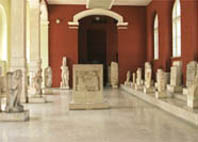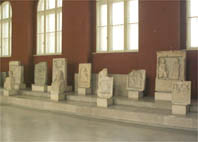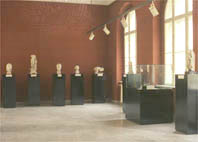|
|
|
Religion
and Burial Rituals
/1st –4th Century/
|
|
|
In the early 1st century AD Odessos was included into the
realms of the Roman Empire. The town and the surrounding region
were influenced by a variety of cultural tendencies. The population
was ethnically varied which explains the variety in the deity pantheon
during that epoch. The supreme god of Odessos was the Thracian
god Darzalas but most widely spread among the local population was
the cult to Heros, the Thracian god-horseman.
The earliest votive tablets dedicated to the Thracian god-horseman
have been discovered in a big sanctuary from the 2nd century AD
near the Galata residential quarters by Varna. /Hall
10A/

|
The marble votive tablets and altars from Odessos
and its surroundings were dedicated to Greek, Roman, Eastern
and local deities such as Dionisius, Zeus, Hera, Nemesis,
Athens, Mars, Mitra and others. /Hall 10/ |

|
In the region are discovered also sanctuaries testifying
to other honored deities – Asclepius, Hygia, Telesphorus,
the three nymphs, the local deity Suregetes /Hall 12A/.
Statues of Heracles, Nike, Jupiter-Dolihenus, Hermes confirm
their popularity especially among the citizens of the town.
/Hall 11/.
The belief in the other life determined the rituals
in attendance on the dead. Part of the big collection of tombstones
exhibited in Hall 11 gives an idea about the burial
rituals during the Roman age. |

|
Most of these tombstones have been worked out in the workshops
of Odessos. Among the scenes depicted on the tombstones prevailing
is the one known as "Funeral Feast". The inscriptions on the
stones give evidence to the ethnic structure of the population
– mainly Greeks and Thracians. Among them there are doctors,
teachers, sailors and others.
Numerous bronze, glass, and ceramic vessels, medical
instruments and utensils have been found in the grave of a
doctor – priest in the nearby town of Dionisopolis /today's
town of Baltchik/ - Hall 12 |
|
| À
r c h e a e o l o g i c a l m u s e u m V
a r n a |
|
www.varna-bg.com
© 1997, 2000; 2002
|
|



